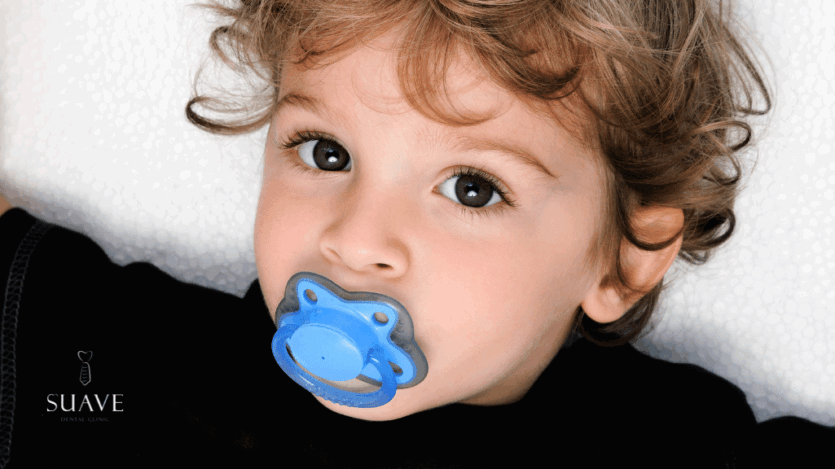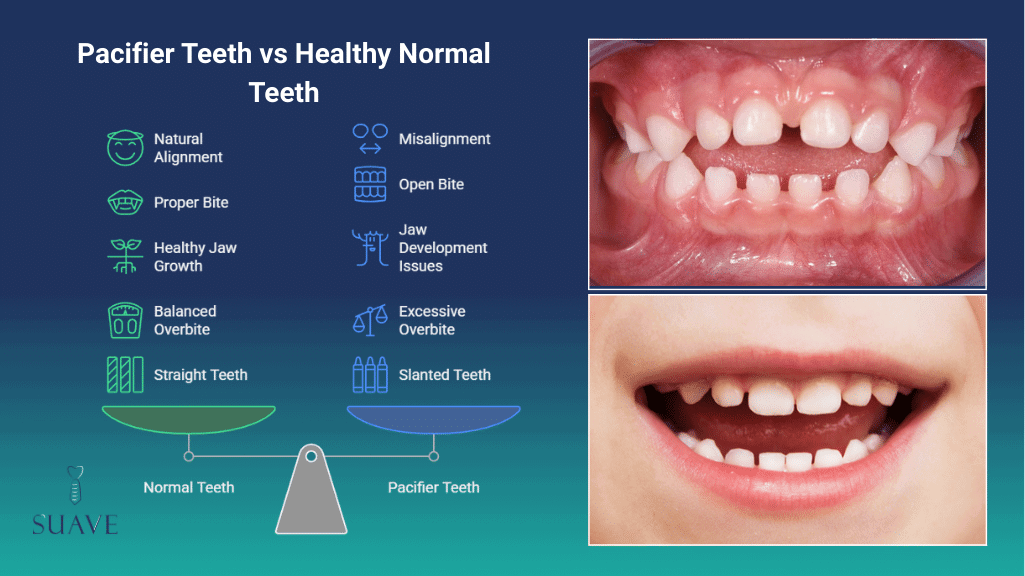
Table of Contents
Pacifiers — whether you call them binkies, soothers, or dummies — often feel like magic solutions for moody babies. They help babies become calmer, support self-soothing, and can even offer some sleep-saving benefits for exhausted parents. They can even reduce the risk of sudden infant death syndrome (SIDS).
However, while they serve a valuable purpose during infancy, prolonged use can affect a child’s dental development.
If you’re wondering when to introduce a dummy when to stop using one? And how to prevent “pacifier teeth,” this guide offers everything parents need to know.
What Do Pacifiers Do? Benefits Of The Pacifier For a Baby.
Honestly, pacifiers can feel like tiny lifesavers during those early, sleepless weeks. But they are more than just a way to calm a crying baby. When used mindfully, pacifiers offer some real benefits for babies and tired parents, especially in the first six months.
Here is why that little binky might be worthy in your baby’s bag:
- A Source of Comfort
Babies are born with a natural habit to suck — it is how they calm down babies and make them feel secure. A pacifier helps meet that need, giving them a sense of calmness (and offering mothers some moments of rest, too). - Better Sleep & Added Safety
Using a pacifier at bedtime may lower the risk of SIDS (Sudden Infant Death Syndrome). - A Gentle Aid for Preemies
For premature babies, pacifiers can be more than soothing — they help tiny mouths practice the sucking motion, easing the transition to regular feeding and helping reduce stress. - Helpful During Weaning
When you are ready to begin the shift away from breastfeeding, a pacifier can gently fill that stressful gap. Just wait 3–4 weeks after birth to avoid interfering with feeding routines.
Do Pacifiers Cause Teeth Problems?
They can — if used too long. While pacifiers are generally safe for infants and toddlers in a wide age range of newborns to 6 months, 6 to 18 months, and 18+ months, prolonged use past the toddler years can interfere with normal dental development and could be bad for Babies’ Teeth.
What are the dental effects of the pacifier?
Pacifiers can bring great comfort in the early stages, but using them for too long, especially beyond the age of 2 or 3, might start to affect your little one’s smile.
There are the side effects of pacifiers
- Long-Term Sucking: If your child continues to use the pacifier beyond the toddler years, it can start to influence how your child’s teeth come in and even how their jaw grows, and cause dental malocclusion, or even developmental malocclusion in severe cases.
- Sugary Pacifier Dipping: Dipping pacifiers in honey or juice may seem harmless, but it can quietly cause tooth decay — baby teeth are more delicate than we think!
- Incorrect Pacifier Use: Constant or aggressive sucking of pacifiers can gradually change how their bite aligns.
What Do Pacifier Teeth Look Like?
It’s not always obvious at first, but here are a few signs to differentiate between Pacifier teeth before and after:
- Shifting or Crowded Teeth: Teeth might start to tilt outward or look uneven, which can cause gaps or tight spaces.
- Open Bite: When your child bites down, their top and bottom front teeth may not touch, leaving a noticeable gap.
- Changes in Jaw Shape: Over time, constant sucking can alter the shape of the upper palate, potentially leading to alignment or spacing issues.
Are There Alerting Symptoms For Pacifier Teeth?
Yes — if your little one holds on to their pacifier too long, it can start to affect their smile and how their mouth grows.
Here are some dental symptoms you should watch for:
- Tooth Alignment Troubles: When pacifier use goes beyond the toddler years, it may lead to bite issues like an open bite, a crossbite, or those front teeth starting to stick out a bit — something dentists call “malocclusion.”
- Jaw and Palate Changes: Constant or forceful sucking might gently reshape the roof of the mouth (the palate), which can affect how the jaw develops over time.
- Gum Recession & Cavities: In rare cases, pacifiers can lead to gum issues, especially when dipped in sugary substances, which promote decay.
- Speech development delays or tongue-thrusting behavior.
If you notice any of these changes, don’t panic — many cases improve naturally after pacifier use ends, but you really must check this with your pediatric dentist.
Studies show the risk of dental issues increases dramatically in children still using pacifiers after the age of 3–4. However, if you stop using it early, many issues can be self-corrected without intervention.

How to Use Pacifiers Responsibly?
The correct way to use pacifiers is to avoid their side effects. Every child is a different case, and no magic age works for everyone.
But if you’re wondering how to use a pacifier in a way that keeps your baby’s smile healthy, and not to cause pacifier teeth. Here is a timeline to guide you
- Between 6–12 months: This is a good time to start limiting pacifier use, especially during the day. It may also help reduce the chances of ear infections
- Between 18–24 months: Now you must think about beginning the weaning process. Slowly limiting the pacifier now can help avoid dental issues later on.
- By age 3: Most dentists agree that it is best to fully stop by this age to prevent any prolonged changes to your child’s bite.
- By age 4: After this point, the chances of your child needing orthodontic treatment increase, and it becomes a bit harder to reverse the effects.
At What Age Should You Stop The Pacifier?
Fortunately, most children naturally stop using pacifiers between the ages of 2 and 4.
So, The Age to take the pacifier away starts from the end of the second year of the baby.
How To Break the Pacifier Habit?
Stopping the binky can be a big deal for both little ones and parents.
But with a little patience and a few playful tricks, you can make the transition phase feel easier and even more exciting!
- Modify the Tip: Gently trim the end of the pacifier to reduce suction — it often makes the binky less satisfying and forces your child to lose interest naturally.
- Make little changes to your life: Trips, holidays, or a new bedtime routine can be the perfect time to phase out the pacifier without too much effort.
- Use the effect of “Paci Fairy”: Create a special story where the “Pacifier Fairy” swaps the binky for a big-kid surprise or gift.
- Give It as a Gift: Invite your child to “donate” their pacifier to a new baby. It’s a sweet way to make them feel proud and grown-up.
- The Gentle Goodbye: Have a loving, honest talk. Then remove all pacifiers at once and stick to the plan with love and consistency even when it’s tough.
- Team Up with the Pediatrician: Sometimes, a little encouragement from the dentist can work, and offering fun rewards for kids who are ready to give up their pacifier.
How To Treat Pacifier Teeth Problems?
If your child has signs of dental problems:
- Stop pacifier use at once.
- Visit a pediatric dentist — early intervention can prevent long-term effects.
- Orthodontic Treatment: Orthodontists may suggest retainers, spacers, Invisalign in mild cases, or appliances for correcting dental problems.
Don’t wait — the earlier the treatment starts, the better the outcomes.
Orthodontic Pacifiers: Are They Better? What’s the Best Pacifier for Teeth?
While no pacifier is completely risk-free, orthodontic pacifiers — with flattened bottoms and rounded tops — are designed to minimize pressure on the gums and jaw.
Orthodontic pacifiers are designed to support naturally sucking motions and jaw positioning.
While they are marketed as more “dental-friendly,” there’s no strong evidence that they completely prevent dental issues with prolonged use.
Get A Free Dental Consultation
Get A Personalized Treatment Plan and Quotation
What is the best pacifier for teeth?!
The good news is that you can enjoy pacifier benefits while protecting your child’s smile. Using Pacifiers without causing Pacifier Teeth prevents the drawbacks of pacifiers in the first place.
Here is How to Use Pacifiers Responsibly and Avoid Damage to the Teeth:
- Choose an orthodontic pacifier.
- Avoid dipping pacifiers in anything sweet.
- Let pacifier use be temporary, not constant.
- Keep an eye on emerging teeth and jaw alignment — catch problems early!
Finally, Pacifiers are not totally harmful — in fact, they can be incredibly helpful when used appropriately during infancy.
If you are unsure about your child’s teeth or oral habits, don’t hesitate to contact us.
Just ask your pediatric dentist or orthodontist — they’re your best partner in keeping little smiles healthy!
Pacifier Teeth FAQs
Will My Baby Develop Pacifier Teeth?
No, not if used reasonably. The key is timely weaning. By using pacifiers in a way that doesn’t cause pacifier teeth, pacifiers are safe and soothing tools in early parenthood. Weaning off by age 2 – 4 helps protect your child’s beautiful smile.
Will Pacifier Teeth Correct Themselves?
In many cases, yes! If you stop pacifier use early (before age of 3 years), the teeth and jaw may realign on their own. But the longer the habit continues, the more likely orthodontic appliances will be needed.
Which is better, thumbs or pacifiers?
Both habits, pacifiers and thumb sucking, can impact the mouth similarly, but thumb-sucking is generally harder to control. A pacifier can be taken away — a thumb can’t. That’s why many dental professionals recommend pacifiers over thumb-sucking, as the habit is easier to manage.
Ignore what Grandmas say, ‘Just let them suck their thumb — it is the safest to put in mouth!’
What Can I Give Instead of a Pacifier?
Try:
Sippy cups or feeding routines
Teething toys
Soft blankets or comfort items
Cuddles and rocking
Gentle lullabies or white noise
When to Consult a Pediatric Dentist or Orthodontist?
If you notice changes in your child’s teeth, such as gaps, a change in bite, or speech issues, it’s time for a dental checkup. Early intervention may prevent the need for more extensive treatment later. Orthodontists can guide jaw growth, correct bite issues, and recommend appliances if needed to help break oral habits.
References
Medically Reviewe